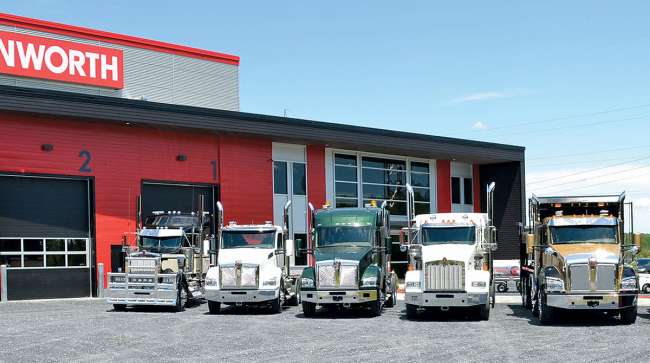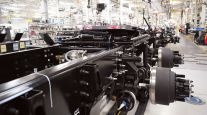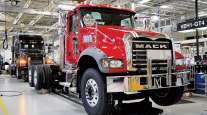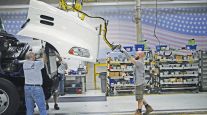Senior Reporter
August Class 8 Orders Underscore Replacement Demand

[Stay on top of transportation news: Get TTNews in your inbox.]
North American Class 8 orders in August reached replacement levels as fleets found the freight market growing stronger despite the many uncertainties in society at large, ACT Research reported.
ACT found the preliminary net orders reached 19,500 compared with 11,119 a year earlier — a 75% increase. OEMs will report final numbers later in the month.
“Consumers are spending not as much money on services, but we are still spending. It’s stuff,” ACT Vice President Steve Tam told Transport Topics. “We are finding other activities, and they seem to be generating freight. It is keeping things rolling.”
Preliminary NA Class 8 net orders in August were 19,500 units, down 4% from July, but up 75% from an easy year-ago comparison.https://t.co/PUiV8TtMTN#truck #semitruck #trucking #transportation pic.twitter.com/eokM7YUZrp — ACT Research (@actresearch) September 3, 2020
ACT has a Class 8 Tractor Dashboard analysis tool that right now has its multiple equipment-demand indicators in balance, he said. “The way we think about that is that is replacement-level demand. It would not surprise to see us stay at this level for the near-term.”
North American replacement demand is seen as 20,000 orders a month.
FTR pegged orders at 20,500.
“We are in a highly uncertain, yet very stable environment in the market,” said Don Ake, vice president of commercial vehicles at FTR. “That sounds strange because it is. You have those uncertainty factors where you have a pandemic, you are coming out of a recession, you have social unrest and a presidential campaign going on. That is a lot of uncertainty to be in the market.”
Freight and the economy are recovering from the recession, he said. “And everybody is basically buying what they need. They are not taking any chances, not taking risks.”
Ake added orders have come into balance with production — both are stable at about the same rate. “We are in a tight holding pattern.”
One fleet executive agreed freight volumes are up and said trucking companies are scrambling to add drivers and/or equipment to handle the surge.
“We are filling some trucks we had sitting as well as purchasing additional equipment,” Riley Larson, general manager at JMS Transportation Inc., told TT. “As far as what the future holds with the pandemic and how the nation responds to it is anybody’s guess, but with our contracted freight and the [health] protocol in place we are confident that now is a good time to grow our fleet.”
The Cedar Rapids, Iowa-based carrier specializes in dry van Midwest regional freight, although it extends farther out as well.
It uses a mix of 50 company trucks and 100 owner-operators.

Tam
Meanwhile, upcoming emissions and fuel efficiency regulations in 2021 and 2024 haven’t yet spawned plans for a cost-saving pre-buy of heavy-duty trucks ahead of those potentially more costly regulations, Tam said.
He said 2021 was not a punitive mandate, and engines that meet requirements have been available for a couple of years.
“There are people who are in 4-year-old trucks who are not benefiting from this technology. They are not pre-buying but they are buying to take advantage of the [fuel economy] technology and the gains they stand to enjoy by doing that,” he said.
Tam said 2024 was a potentially different story as engines then must meet even tougher federal CO2 and fuel efficiency standards. And there is likely to be a new nitrogen oxide (NOx) factor, too.
ACT believes there will be a big cost associated with meeting the 2024 standard. But it is too early from a strategic standpoint for fleets to be changing their buying patterns, Tam said.

What are fleets doing to help attract the best possible diesel technicians to join the changing workforce environment? Host Michael Freeze speaks with Ken Boyer, dean of the Auto/Diesel Institute at Baker College, and Ralph Romero, vice president of talent management at U.S. Xpress. Hear a snippet, above, and get the full program by going to RoadSigns.TTNews.com.
“But it is certainly a strategy in the back of people’s minds. When I look at our forecast, and now especially since California voted to adopt their ultra-low-NOx standard for 2024 [a federal low-NOx standard is months behind schedule], we are going to be hearing more and talking more about that because that is going to be very disruptive to the industry,” Tam said.
Each OEM may select different technology pathways to hit their milestone targets — there are separate targets for engines, vehicles and trailers, said Glen Kedzie, environmental affairs counsel for American Trucking Associations.
“Some packages may cost more than others so we will find out soon,” he said. “The inclusion, or price tag, of new trailers under Phase 2 will be decided as the case goes to trial late summer or early fall this year.”
Want more news? Listen to today's daily briefing:
Subscribe: Apple Podcasts | Spotify | Amazon Alexa | Google Assistant | More




